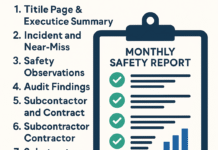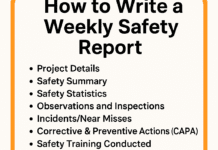
Safety Documents in the Workplace: Ensuring a Secure Work Environment
Safety in the workplace is paramount to the well-being of employees and the success of a business. Ensuring a secure work environment involves various measures, one of the most important being the implementation of safety documents. These documents serve as guidelines and protocols to prevent accidents, mitigate risks, and comply with legal requirements.
Types of Safety Documents
Risk Assessments
One of the fundamental safety documents is a risk assessment. This document identifies potential hazards in the workplace and evaluates the level of risk associated with each hazard. By conducting regular risk assessments, businesses can proactively address safety concerns and prevent accidents.
Safety Data Sheets (SDS)
Safety Data Sheets, also known as SDS or Material Safety Data Sheets (MSDS), provide detailed information about hazardous chemicals and substances used in the workplace. These documents outline the proper handling, storage, and disposal procedures to ensure the safety of employees and minimize environmental impact.
Emergency Procedures
Emergency procedures documents outline the steps to be taken in the event of an emergency, such as fires, natural disasters, or medical emergencies. Clear and concise emergency procedures ensure that employees know how to respond quickly and effectively, minimizing potential harm and property damage.
Safety Manuals
Safety manuals encompass a comprehensive set of safety policies, procedures, and guidelines tailored to the specific needs of a workplace. These documents cover a wide range of safety topics, including equipment operation, personal protective equipment (PPE) usage, and ergonomic practices.
Legal Requirements
Compliance with safety regulations is not only essential for protecting employees but also for avoiding legal repercussions. Government agencies such as the Occupational Safety and Health Administration (OSHA) set forth regulations and standards that businesses must adhere to regarding workplace safety. Failure to comply with these regulations can result in fines, penalties, and legal liabilities.
Creating Safety Documents
Creating effective safety documents requires collaboration between management, safety professionals, and employees. It is crucial to involve employees in the development process to ensure that the documents reflect the realities of the workplace and are easily understood by all staff members. Seeking professional assistance from safety consultants or legal experts can also help businesses create comprehensive and legally compliant safety documentation.
Training and Communication
Employee training programs play a vital role in ensuring the successful implementation of safety protocols. Regular safety meetings and communication channels for reporting safety concerns foster a culture of safety awareness and encourage employees to actively participate in maintaining a secure work environment.
Importance of Accessibility
In addition to creating safety documents, it is essential to ensure that they are readily accessible to all employees. While traditional paper-based documentation may suffice in some cases, digital formats offer greater flexibility and accessibility, especially in emergency situations. Employers should consider the needs of all employees, including those with disabilities, and provide documentation in accessible formats as necessary.
Implementing Safety Procedures
Implementing safety procedures requires more than just creating documentation; it involves integrating safety protocols into daily operations and enforcing compliance. Regular inspections, audits, and feedback mechanisms help identify areas for improvement and ensure that safety standards are consistently met.
Benefits of Comprehensive Safety Documentation
Comprehensive safety documentation not only reduces the risk of accidents and injuries but also provides legal protection and enhances the reputation of a business. By demonstrating a commitment to safety, businesses can attract and retain employees, improve productivity, and differentiate themselves in the marketplace.
Challenges and Solutions
Despite the benefits of safety documentation, businesses may encounter challenges such as resistance to change, language barriers, and the complexity of managing documentation. Addressing these challenges requires proactive measures, such as employee education and training, multilingual documentation, and the use of software solutions for document management.
Measuring Effectiveness
Measuring the effectiveness of safety programs is essential for identifying areas for improvement and demonstrating ROI. Metrics such as injury rates, near-miss reports, and safety compliance audits can help businesses assess the impact of their safety initiatives and make data-driven decisions to enhance workplace safety.
Costs and ROI
While implementing comprehensive safety documentation requires an initial investment of time and resources, the long-term benefits far outweigh the costs. By reducing accidents, injuries, and associated expenses, businesses can achieve a positive return on investment and protect their most valuable asset—their employees.
Conclusion
Safety documents play a crucial role in ensuring a secure work environment and complying with legal regulations. By investing in comprehensive safety documentation, businesses can protect their employees, minimize risks, and enhance their reputation. Prioritizing safety not only benefits employees but also contributes to the overall success and sustainability of a business.
Safety Management Plan in Coal Mines
Safety Management Plan Example
FAQs
- What are safety documents? Safety documents are written guidelines, procedures, and protocols designed to prevent accidents, mitigate risks, and ensure compliance with safety regulations in the workplace.
- Are safety documents legally required? Yes, businesses are legally required to maintain certain safety documents, such as risk assessments, safety data sheets, and emergency procedures, to comply with occupational health and safety regulations.
- How often should safety documents be updated? Safety documents should be reviewed and updated regularly to reflect changes in the workplace, equipment, regulations, and best practices. It is recommended to review safety documentation at least annually or whenever significant changes occur.
- What happens if a company fails to provide proper safety documentation? Failure to provide proper safety documentation can result in fines, penalties, legal liabilities, and reputational damage. Additionally, it puts employees at risk of accidents, injuries, and illnesses.
- Can safety documents improve employee morale? Yes, comprehensive safety documentation demonstrates a commitment to employee well-being and creates a positive work environment. Employees feel safer, more valued, and more motivated when their employer prioritizes their health and safety.





















